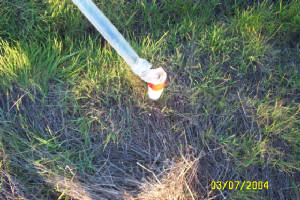|
FTC and T-nozzle
On this page I will talk about our on going experiments with FTC rockets and T-nozzles. I might eventaully separate FTC rockets
and T-nozzles into two pages. For now they will be on the same page. For those of you who are not farmilar with the meaning
of FTC it stands for florecent tube covering. More commonly known as flourecent light bulb covers. They are extremely inexpensive
and make great water rockets. We bought our supply at HomeDepot for about a buck a piece. That's the same price we pay for
a soda bottle. FTC rockets are extremely aerodynamic, which makes them great for water rockets. Arodynamics is the one biggest
factor in a water rockets performance.
My Firtst Rockets
Black Knight
Movies/galleries
This weekend we launched off our first FTC rocket. It was an interesting day. The first two launches the rocket backslid.
On the third launch we tried using about a cup of water. The rocket slot off the launch pad like a bullet being fired from
a gun barrel. It was a beautiful flight. The rocket went straight up. It began to backslide and then it came down nose first
and stuck into the ground like a spear. The nose-cone was twisted like a medal frame work after a hurricane. I think that
the rocket came down nose first because the center of gravity moves forward as the rocket accelerates. So when we used less
water the rocket accelerated faster, so the center of gravity moved foward of the center of pressure and as a result the rocket
came down nose first. We will have pictures of the twisted nose-cone soon.
This is a close up of the nose-cone.
| Lawn dart |

|
| Click on picture to enlarge |
This is a picture of the nose-cone after the rocket came down nose first.
| Lawn Dart clse-up of nose-cone |

|
| click on picture to enlarge |
After our first FTC rocket come down nose first, we built a new one. We saved the fins from our old rocket, because the fins
are the most time consuming part of build a water rocket. We hoped that our new rocket would back-glide. We did not have time
to run the center of area vs. center of gravity in the computer, but the center of graviy was far below the mid point, so
we were willing to take the chance. We were also able to film some of the launches. To see a short clip, of a launch click
on the link below.
click here to play video
|

